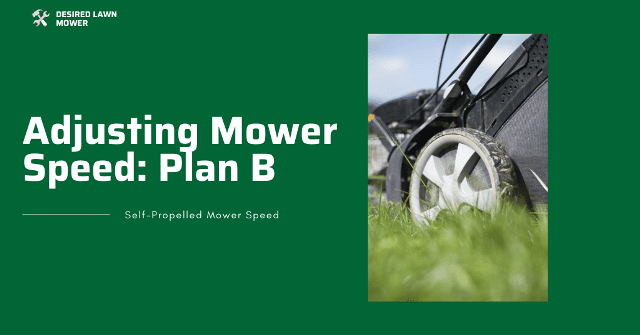How To Adjust Speed on a Self-Propelled Mower: Am I Missing a Step?
It can be outright frustrating operating a mower that proves a little tricky to handle. No one has the time to be stuck hopelessly fiddling with their machine in the middle of a mowing session on a hot sunny day. Sometimes, succumbing to the problem will even be much easier to do since all you have to do is run after your machine like a pissed-off goose for the sake of achieving a nicely cut yard.
In most cases, this puny problem is faced by people who are getting familiar with self-propelled mowers or people who have gotten a new brand, so changing the speed can be met with slight resistance from the machine. Worry not because this article is here with the easiest instructions to help you overcome the dilemma. I will be explaining the step-by-step procedure for changing the speed of your machine, including other possible reasons why your self-propelled mower doesn’t move as slow or as fast as you would have it.

Here are 7 steps to help you adjust your self-propelled mower speed:
Table of Contents
Step 1: Find a Nice, Flat Surface
You wouldn’t find your “tempo fixing” effective if your self-propelled mower is tilted or unstable. Since you’re dealing with speed, the first thing to do is remove any speed-affecting filters out of the way to warrant a much more accurate result of your highly renowned engineering skills!
Step 2: Allow Your Self-Propelled Mower to Catch Some Cool Air
The mower needs to be cool and calm to properly outcome the adjustments. You would need a fresh start to fully understand the whys and hows of your procedure just in case the problem is more than you anticipated. Let’s say a drive belt problem or something to do with the transmission. Letting your mower cool before getting all handy and crafty will tick off all the protocols for much better clarity.
Step 3: Does Your Mower Have a Throttle Lever?
Some highly advanced self-propelled mowers do not have throttle levers, and the function is replaced by a knob for regulating the transmission of the machine.
If your mower has a throttle lever, you’ll find it close to the bail lever shaped like a cute little “T” or a little door handle.
Now, place the throttle lever on the Choke Position for this step.
Otherwise, if you find a transmission knob, all you have to do is loosen this knob and pull the cable towards you to increase speed, and away from you to decrease speed. Tighten the knob after this adjustment to seal the deal. You may have to try the knob adjustment a couple of times to find a sweet spot that will alleviate the problem– and just like that, your self-propelled mower is fixed.
Step 4: Turn The Engine On
Pull the mower start-engine cord, turn on the switch, press the key, or ask the machine politely– whatever would start the engine should do.
Step 5: Move The Throttle Lever To The Desired Position
As soon as the mower is turned on, remove the throttle lever from the choke position to the estimated spot of the speed you want. The throttle goes all the way to the max to increase speed and can be pulled away from the max to reduce speed.
Step 6: Adjust The Blade Speed
There’s a rocket button for blade speed engagement. All you have to do is press the far end away from you to engage the blades, and press the opposite direction to disengage. Turn the blades on before propelling the machine.
Step 7: Push The Mower Drive Clutch To Propel The Mower
After engaging the blade speed, push the drive clutch to move the mower forward. The drive clutch will become highly proportional to the amount of force you place on it after following this step-by-step rule.
On some high-grade self-propelled mowers, there’s a speed lever clutch to regulate the speed of the machine– all you have to do is tighten your grip accordingly. These steps only apply if you are just getting to use the machine and are a little confused about the controls and how to maneuver the mower.
“I Have Followed The Steps and Nothing’s Changed!”- Here’s Your Plan B:

In most cases, the speed is proportional to the movements of the drive clutch. So, if you’re facing speed problems – maybe your mower is too slow or too fast for comfort – it could be because of other reasons other than the control system. Read on to see 5 good in-depth tips to adjust your self-propelled mower’s speed!
- Regulate Your Governor Spring
The governor spring is a linkage between the governor arm and the throttle control. If you’re wondering what the governor is, it is simply an arm that controls the opening and closing of the carburetor, thereby influencing the amount of fuel that goes into the engine and the relative speed of the engine.
If the governor spring dangles between the throttle and the governor’s arm, the machine will move slower. So to increase the speed of your mower, all you have to do is pull the governor arm against the spring until the spring feels stretched and tight. This will allow more fuel into the engine in turn increasing the general speed of your machine.
- Take a Peek at Your Drive Belt
In most cases, the drive belt is the main culprit for a rickety or slow mower. If your drive belt is torn or worn out, this could affect the speed of the mower immensely. Check to see if the belt needs to be replaced on your machine if other steps don’t work.
- Check Your Battery Power
If your battery has run out of bars, there is no way your mower will ride on as you expect it to. If your self-propelled mower is new and you suspect battery problems, make sure to return it for a replacement as soon as you can. You can tell this if your engine throws a fit before it cranks, or if it cranks rather slowly for a reasonable rate.
- Ensure The Cutting Blade(s) Are in Good Shape
If the cutting blade of the self-propelled mower is blunt or bent at a suspicious angle, the speed of the machine will be affected. This could either affect the blade speed itself, or the effectiveness of cutting grass.
- Examine Your Engine in Case of Clogging
Clogging is a common problem for mowers with the choke operation. It is normal for combustion engines to get overpowered by the little amounts of fuel needed to start up the engine. In most cases, the fuel isn’t quite the right blend for your mower and sooner than you expect, the problems start to surface.
This will take a toll on the combustion as residues that were ideally meant to be burned out get trapped in valves and grooves of segments choking and clogging the engine. There’s no guessing what would follow asides from the negative impact the problem would have on the effectiveness and speed of your mower.
To avoid or better the situation, pay a visit to your dealer for a proper check of your machine; they will easily figure out if you’re using the wrong fuel blend or if your engine is clogged.
The Much-Needed Conclusion
Adjusting the speed of your self-propelled mower could easily be the best or worst-case scenario. From simple steps to grave problems that wouldn’t look so fun to fix. The best place to start is the step-by-step guide, but even if that works for you I would still suggest you make a good general check-up of your machine. You really couldn’t tell– who knows what secrets your mower is hiding? I doubt you’d love to find out too late.







